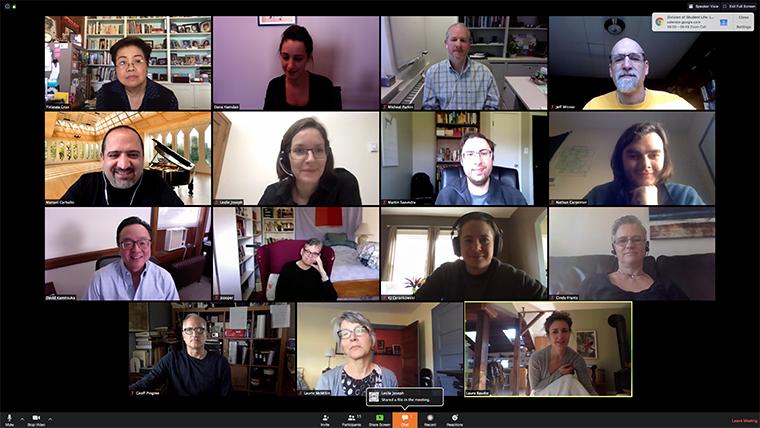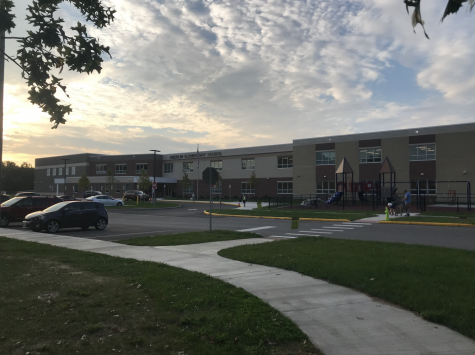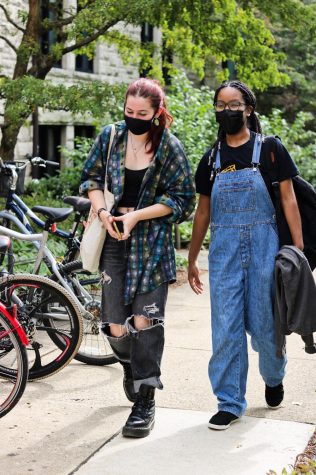COVID-19, Three-Semester System Create Extra Demands for Faculty
In the last year and a half, Oberlin professors have reassessed syllabi, adapted to the hybrid mode of teaching, experimented with different assignments and grading formats, and adjusted to a reformatted academic year. Longer work hours and fewer opportunities to pursue professional and personal goals have contributed to a feeling of burnout among some faculty members.
“I think every person in the workforce, everyone in Oberlin — students, staff, and faculty — and the world is experiencing burnout,” said chair of Comparative American Studies and Professor of History Shelley Lee. “I don’t think what I am experiencing as a faculty member is particularly extraordinary or unusual, but that said, it was a tough year.”
Donald R. Longman Professor of English and Acting Chair of Comparative Literature Anuradha Needham felt this burnout too, and the year overall helped solidify her decision to retire after the 2021-22 academic year.
“I don’t want to be in a situation where it really is very, very time-consuming to teach this way,” Needham said. “You’re exhausted at the end of it because it takes that much more emotional energy out of you.”
Chair of the Department of French and Italian Matthew Senior explained that many faculty members entered COVID-19 already burdened with several responsibilities added to faculty positions by the One Oberlin recommendations such as staff recruitment, webpage re-designs, and other administrative tasks.
“The entire summer of 2020 was devoted to creating a three-semester academic year,” Senior wrote in an email to the Review. “Normally, faculty uses the summer to catch up on their research and prepare courses for the coming year. As a result of budget cuts, staff positions are being cut; new platforms and software programs are replacing people; this adds to faculty workload. In truth, I have been working seven days a week, around the clock, since the beginning of the pandemic. I am sure all of my colleagues have been doing the same.”
In a normal year, faculty members balance teaching responsibilities with their own personal research — a priority because generating new work is central to their roles as academics. However, with last summer dedicated to planning a COVID year, and ongoing classes now, professors have struggled to make time for research. Even though some professors aren’t teaching right now, heads of departments still have to coordinate their teams and facilitate courses.
“I began this [research] project two years ago and I have this working mechanism, where I say it takes me seven years to finish something,” Needham said. “I’m not even close, because two years are just completely wiped out.”
With faculty feeling overburdened by the three-semester system and other challenges created by COVID-19, the administration has implemented some changes to give faculty more flexibility.
“The pandemic has made it difficult for many faculty members to pursue their academic and artistic research, and abruptly transitioning to remote and hybrid instruction has been a heavy lift,” wrote Dean of the College of Arts and Sciences David Kamitsuka in an email to the Review. “The Dean’s Office and our elected College Faculty Council are well aware of these difficulties and have taken steps to support our faculty, whether through additional time on the tenure track or additional research funding support.”
Outside of research, the sheer administrative challenge of organizing courses and professor schedules was an additional strain on department chairs.
“I chair a very small department with only four core faculties, so we don’t have a lot of courses,” Lee said. “It was really tough for small departments that were asked to spread their curriculum across three semesters. Particularly when there are some classes that are requirements for majors. In addition, we had to make decisions about when to offer those particular courses, which put some students in a very bad situation because they were not going to be able to take the class when it was offered.”
Kamitsuka acknowledged the difficulties faculty faced during COVID-19, saying, “There were countless logistical and technical challenges in delivering a high-quality educational experience under pandemic conditions. I am deeply grateful for the ways in which Oberlin worked together to make the 2020-21 academic year possible for our students.”
Part of the institutional reorganizing prompted by COVID-19 was the three-semester academic calendar for the 2020-2021 academic year. According to Kamitsuka, the Dean’s Office made the decision to move forward with the three-semester plan based on the support of the faculty. When surveyed, the Arts & Sciences faculty preferred the three-term model by a significant margin, the plan was endorsed by EPPC, and the Board of Trustees ultimately made the temporary health emergency decision to alter the 2020-21 academic calendar.
“Last summer, the Dean’s Office had regular and special meetings with faculty and faculty governance committees about the best educational and public health options for the 2020-21 academic year,” Kamitsuka wrote. “Based upon our survey of Arts & Sciences faculty, it was clear that the faculty favored the de-densified three-semester option.”
While the survey may have represented a positive opinion of the plan, Senior, who is a member of the American Association of University Professors, says that there was no official vote among faculty members before the plan took effect.
“Faculty were surveyed before the adoption of the three-semester plan, but there was not a formal vote, which there should have been, according to AAUP policies and Oberlin’s own bylaws,” Senior wrote.
Technological adjustment presented another obstacle for professors during remote and hybrid learning modes through the pandemic. Learning how to conduct classes via Zoom — especially in hybrid formats when some students would be learning in-person and some would be joining through Zoom posed a challenge for many professors.
“You would have half the students in the classroom, the other half learning remotely, which meant I had to learn how to use the camera in the classroom while figuring out a whole new pedagogy of how to engage a class when half of the students are there and the other half are remote,” Lee said. “There were technology problems with things not working the way they were supposed to. I was on my toes constantly and did not know what to expect, which was a huge source of stress and exhaustion everyday.”
Another element of concern for faculty has been the heightened ambiguity around job security, as pandemic-induced economic instability exacerbated the pre-existing financial strain at the College.
“Oberlin does not have any policy whatsoever in our bylaws or faculty guide related to the elimination of programs and faculty positions during a financial crisis,” Senior wrote. “For this reason, in December of 2018, 13 Oberlin faculty members sponsored a motion to incorporate AAUP guidelines concerning financial exigency into our faculty guide. The motion passed in College faculty by a vote of 80 to 21 and in general faculty by a vote of 137 to 19. So far, our Board of Trustees has not ratified these votes. The College remains without a policy on financial exigency. This has created a feeling of malaise on campus.”
While individuals have found clarity on their priorities, Lee believes that standing burnout concerns for both faculty and students can be addressed if the College reassess its priorities.
“If there is widespread burnout among students, that has to be understood, not just acknowledged,” she said. “The low morale in the faculty needs to be taken seriously too. How do we acknowledge how people are doing on the ground and take substantive steps to try to elevate people who are not doing so great?”
Still, Kamitsuka believes that the efforts of the community can be credited to the overall success of this year.
“This has been a very challenging time for everyone, both on campus and around the world,” Kamitsuka wrote. “But I have been inspired and energized by the dedication and creativity of our faculty, staff, and students in making this academic year a success.”
Despite the overwhelming challenges of the past year, faculty members still value their relationships with students.
“I had some of the most meaningful exchanges with my students I have ever had,” Senior wrote. “I asked them to keep their own private journal about the pandemic. We shared parts of our journals, but the remainder, the unshared and ungraded pages, kept as a private memorial for future years, were perhaps the most important part of the class.”








